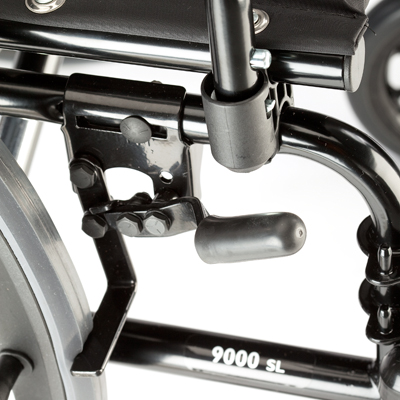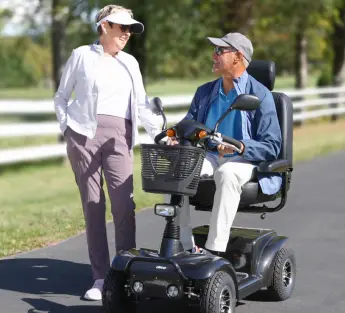Wheelchair Brake Basics

If you are a manual wheelchair user who has opted not to use brakes, please read on. You might want to reconsider.
The most common reason that people do without wheelchair brakes – or "wheel locks" - is that they want to protect their thumbs from jamming into the metal piece that presses into the tire when the brake is engaged. If you catch it with your thumb during a push – Ow, that hurts!
This is most likely to happen for people who grasp the wheels’ handrims with their fingers while resting their thumbs on the tires. This is an efficient grasp that is actually easier on the muscles and tendons of the wrist and forearm. It is possible to develop a technique of wheeling where the thumbs come away from the tire as they approach the brake.
The danger of this is greatest during sports, when you lean into the wheels and making longer strokes, keeping grip of the wheel during more of its rotation. Athletes who use their daily chair for sports sometimes leave their brakes off of the wheelchair all the time just to save the trouble of taking them off when they want to play sports. There are some wheelchair models that are designed to be quickly transformed from street to sports use, such as the Quickie R2.
"Thumb jamming" can happen during normal, daily wheeling, too. This might be a question of how the brakes are adjusted, with the brake extending too far out into the space between the wheel rim and the push rim. Or perhaps too small of a wheel size is being used. That would bring your hands in much easier proximity to the brake.
So what’s the problem with doing without brakes? Lots. It sets up conditions that can lead to physical overstrain.
Veteran wheelers know that the world is not very flat – and that includes floors in buildings! Especially with the light weight and excellent balance of modern wheelchairs, it only takes a very slight slope to start you rolling. Without brakes, the only answer to this is to hold onto something, lean on a table, or perhaps pull up to some obstacle that will keep you from rolling. Most of the time, it means exerting your hands, arms, and shoulders to stabilize yourself, and this falls into the category of "unnecessary exertion" that can lead to chronic pain problems over the long term. Using your brakes is a meaningful proactive measure to protect your body.
Even on a level surface, your arms will do more work without brakes. If you remember your high school physics, you’ll recall Newton’s law of equal and opposite reactions. That means, for instance, that if you reach for something on a table, are washing the dishes, or any number of activities that you perform with your arms, the very activity will push back against your body and cause you to wheel backwards. Again, the only natural response is to grab onto something to stabilize yourself or adopt awkward postures. It can also put a lot of strain on your back.
So the answer? Use brakes, of course. But you have some choices. Many chairs offer "under seat" brakes as an option. When they are not engaged, they fold fully underneath the wheelchair seat, so there is no risk of jamming your thumb. The downside is that engaging the brake requires reaching under the seat and bending the wrist, another risky activity that can lead to injury in the long term. And since they’re not as convenient to engage, many people end up not braking in the situations just described. Still, many people like them.
Some manufacturers are trying to come up with designs to solve this. Otto Bock has a brake which uses the typical side lever to engage it, but the stem that contacts the tire to brake it pivots out of the way when not engaged.
Wheel locks are an essential part of any wheelchair. In the long run, you’ll be protecting your body, extending your mobility, and increasing your comfort.
Just watch out for those thumbs!





 Contact Us
Contact Us
 M-F 9am - 6pm ET
M-F 9am - 6pm ET
 Request parts
Request parts Request Service
Request Service
